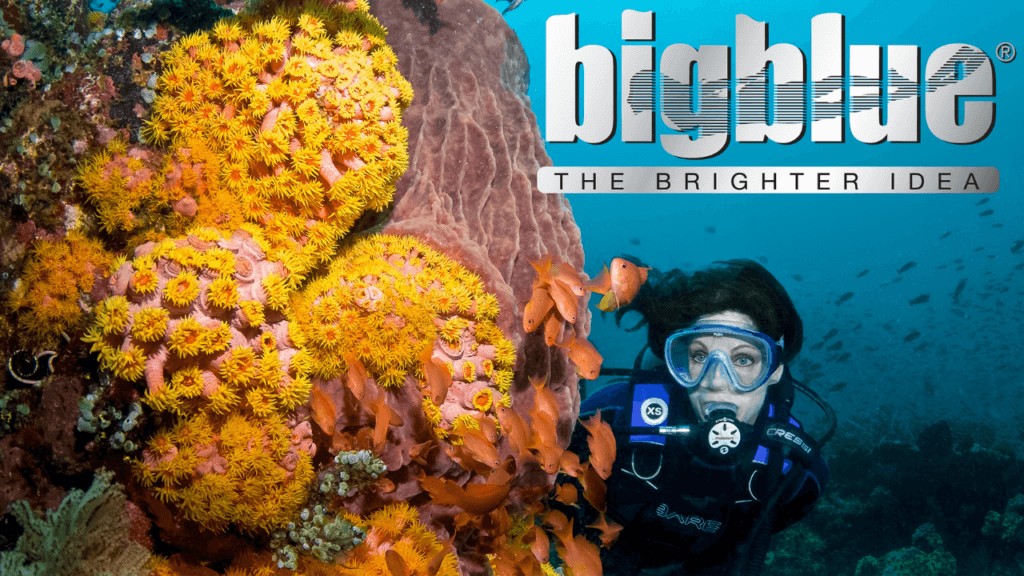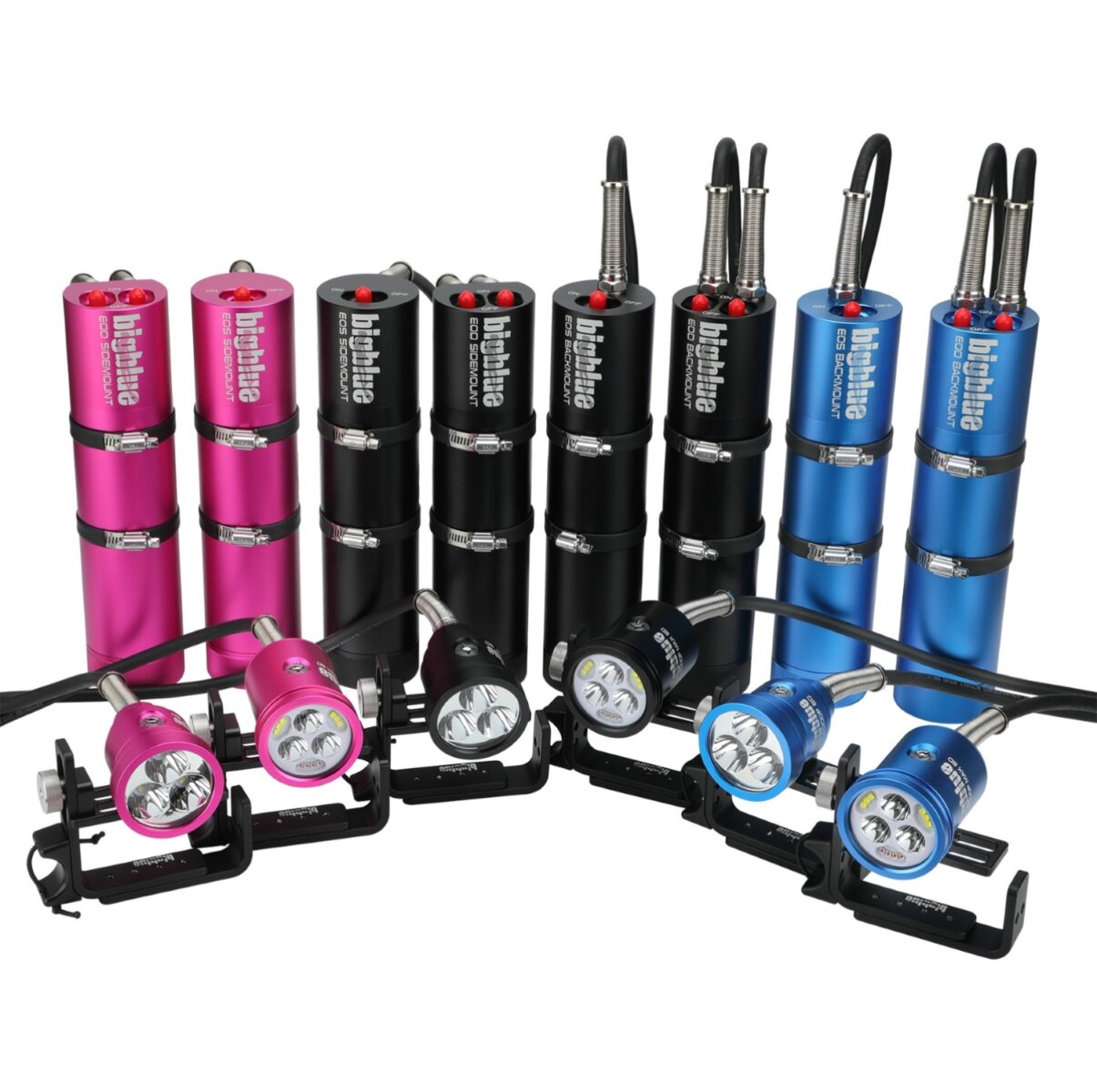Bigblue’s New Canister Dive Lights for 2025: (EOD/EOS) TL4000P and VTL7000P-MAX
TL4000P Canister Light: Precision Lighting for Technical Dives
The TL4000P is crafted for divers seeking a focused, high-performance beam in a compact design. With a 10-degree narrow beam, this light delivers precise, concentrated lighting, perfect for illuminating small spaces or navigating murky conditions. Whether you’re diving in caves or exploring wrecks, the TL4000P provides the clarity and focus technical divers rely on.
Key features of the TL4000P:
- 10-degree narrow beam for pinpoint illumination
- Side-mount and back-mount options for setup flexibility
- Extended battery life to support longer, more challenging dives (12 Hour burn time on High)
VTL7000P-MAX Canister Light: Dual Beam for Ultimate Flexibility
For those who need adaptable lighting, the VTL7000P-MAX offers unmatched versatility. Equipped with a dual beam, this light allows divers to switch between a 120-degree extra-wide beam for broader visibility and a 10-degree narrow beam for focused work. This adaptability is ideal for underwater photographers, videographers, and exploration divers.
Highlights of the VTL7000P-MAX:
- Dual beam design (120-degree wide beam and 10-degree narrow beam) for diverse applications
- Side-mount and back-mount options for personalized setup
- High output and extended burn time, providing consistent lighting for long dives (12 Hour burn time on High)
With the VTL7000P-MAX, divers can quickly transition from lighting entire underwater landscapes to focusing on specific details, making it the ultimate tool for dynamic underwater environments.
Interchangeable Light Heads & Accessory Power: Customization for Every Dive
One of the standout features of Bigblue’s new 2025 canister lights is the ability to interchange light heads. This feature offers divers unparalleled flexibility, allowing you to adapt your setup for different diving environments and specific tasks. Whether you need a narrower, concentrated beam or a wider field of light, swapping out light heads makes it easy to tailor your lighting to any dive. This modular design also makes it more convenient to upgrade or replace light heads without investing in a whole new light system.
Additionally, these canister lights include the option to power other battery-powered accessories using a blind plug. This means you can connect external accessories, like heated vests or underwater cameras, directly to your canister light’s power source. With a simple plug-and-play design, the blind plug option keeps your setup streamlined and ensures you have all the power you need for various equipment during a dive—without having to carry extra batteries.
By combining interchangeable light heads with accessory power capabilities, Bigblue’s 2025 canister lights provide divers with a highly versatile, customizable lighting solution that meets the demands of diverse underwater environments and specialized tasks.
How to Choose Between EOS and EOD Canister Dive Lights:
When it comes to canister dive lights, choosing the right model for your underwater adventures is essential. The two most popular options available in the market today are the EOS (EO Cord with Single Port) and EOD (EO Cord with Dual Port) canister dive lights. Both have unique features that cater to different diving needs. This guide will help you understand the benefits of each type and how to select the best option based on your specific requirements.
Understanding Canister Dive Lights
Canister dive lights are designed to provide reliable and powerful illumination underwater. They consist of a battery canister and a light head connected via a cord, allowing for extended burn times without the bulk of traditional handheld lights. The choice between a single port and a dual port configuration can significantly impact your diving experience.
EOS (EO Cord with Single Port)
Benefits:
- Simplicity and Reliability: The EOS canister features a single port, making it a straightforward choice for divers who primarily need a single light source. This design minimizes the risk of mechanical failure since there are fewer components.
- Lightweight Design: With only one port, the EOS canister is typically lighter and more compact, making it easier to carry on dives where every ounce counts.
- Cost-Effectiveness: Single port models tend to be more affordable than their dual port counterparts, making them an excellent choice for budget-conscious divers.
Ideal Scenarios for EOS Use:
- Recreational divers who primarily need a reliable light source for visibility.
- Beginners or occasional divers who may not require additional powered devices.
- Night dives where a single strong light is sufficient for navigation and exploring.
Potential Drawbacks:
- Limited versatility, as the single port restricts the ability to power additional devices like heated vests or gloves.
- If the light source fails, you won’t have a backup powered from the same canister.
EOD (EO Cord with Dual Port)
Benefits:
- Versatility: The EOD canister comes equipped with two ports, allowing divers to power not only the dive light but also additional devices such as heated vests, gloves, or body suits. This feature is particularly beneficial for cold-water divers who require thermal protection.
- Redundancy: With the ability to connect two devices, the EOD provides a backup option. If one device fails, the other can still operate, enhancing safety during dives.
- Increased Comfort: By being able to power heated gear, divers can maintain body warmth and comfort during extended dives, leading to a more enjoyable experience.
Ideal Scenarios for EOD Use:
- Technical divers or those engaging in long-duration dives in cold waters where maintaining warmth is crucial.
- Divers who frequently use additional equipment and want the convenience of a single power source.
- Night dives where having a secondary light source or heated gear is advantageous.
Potential Drawbacks:
- Heavier and bulkier than single port models, which can be a consideration for divers concerned about weight.
- Generally higher price point, which may not be justifiable for occasional divers.
Making Your Decision
Choosing between the EOS and EOD canister dive lights boils down to your specific diving habits and needs:
- Diving Environment: If you primarily dive in warm, shallow waters and don’t require extra equipment, the EOS may be ideal. Conversely, for cold-water dives or those involving extended exploration, the EOD offers greater flexibility.
- Equipment Usage: Consider how often you use heated gear or plan to incorporate multiple devices. If these accessories are part of your diving routine, the dual port option will serve you well.
- Budget Considerations: If you’re just starting or diving occasionally, the EOS provides a cost-effective solution without sacrificing reliability.
- Dive Duration: For longer dives, particularly in colder environments, the added benefits of the EOD in terms of powering heated clothing can significantly enhance your experience.
In summary, both EOS and EOD canister dive lights have their distinct advantages, making them suited for different diving scenarios. By assessing your diving habits, environment, and equipment needs, you can make an informed decision that will enhance your underwater adventures. Whether you opt for the simplicity of the EOS or the versatility of the EOD, investing in a quality canister dive light will ensure you have the illumination necessary for safe and enjoyable dives.
Ready to Dive with Bigblue?
Bigblue’s 2025 canister lights raise the bar for underwater illumination. The TL4000P and VTL7000P-MAX deliver precision, flexibility, and dependability, helping divers make the most of every dive.
Explore more in our 2025 catalog. We look forward to showcasing these cutting-edge lights at DEMA 2025 – Booth 9193 —don’t miss your chance to experience the future of dive lighting!

